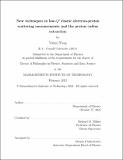New techniques in low-Q² elastic electron-proton scattering measurements and the proton radius extraction
Author(s)
Wang, Yimin
DownloadThesis PDF (47.88Mb)
Advisor
Milner, Richard G.
Terms of use
Metadata
Show full item recordAbstract
The proton charge radius is a fundamental property of the proton, sensitive to its charge distribution. The proton radius puzzle is the discrepancy between the muonic hydrogen spectroscopy measurement of 0.84 fm and the consensus of 0.88 fm from two traditional methods, electron-proton scattering and electronic hydrogen spectroscopy. A recent electron-proton scattering experiment, PRad, measured a smaller radius but also large electric form factor values within 0.02 ≤ Q² ≤ 0.06 (GeV/c)² conflicting with previous experiments. Motivated by those issues, we developed an innovative background-free target system, including a windowless gas jet target, a beam halo collimator and an active beam halo veto, to measure the proton electric form factor at momentum transfers of 0.01 ≤ Q² ≤ 0.065 (GeV/c)². The experiment was conducted in early 2020 at the three-spectrometer facility of the A1-collaboration at the Mainz Microtron in Mainz, Germany. Due to the COVID-19 lockdown, we measured the cross section only up to Q² = 0.043 (GeV/c)² with limited statistics. Although our form factor data cannot give a definitive answer to the form factor discrepancy and the proton radius puzzle yet, our work demonstrated the feasibility of such a background-free target design and we believe that further data taking with this technique can help to resolve the radius puzzle. In this work, we also study the extraction of the proton charge radius using non-parametric models. We demonstrate that the kernel ridge regression and the Gaussian process have similar levels of performance compared to the traditional function fitting approaches. Our extracted values from different data sets still show the discrepancy of the proton charge radius, supporting the point of view that the discrepancy originates from the data itself instead of the extraction method.
Date issued
2022-02Department
Massachusetts Institute of Technology. Department of PhysicsPublisher
Massachusetts Institute of Technology